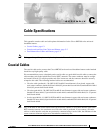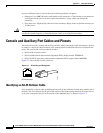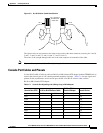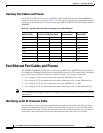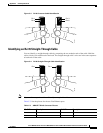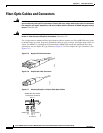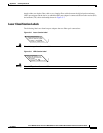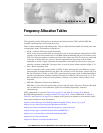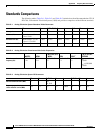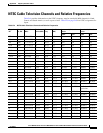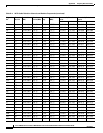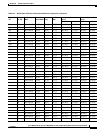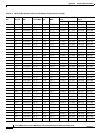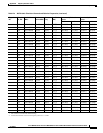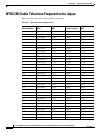
D-1
Cisco uBR7100 Series and Cisco uBR7100E Series Universal Broadband Router Hardware Installation Guide
OL-5916-01
APPENDIX
D
Frequency Allocation Tables
This appendix provides information on broadcast and cable television NTSC and PAL/SECAM
standards and frequencies used around the world.
There are three standards for transmitting video. They are defined by the method of encoding color onto
a monochrome signal. The methods are defined as:
• NTSC—National Television System Committee
NTSC is the current standard used for analog television in the United States and elsewhere. NTSC
supports color television transmission in a 6-MHz channel bandwidth and has 525 interlaced scan
lines. Two fields are interlaced to make one frame with a frame rate of 29.97 frames per second and
a field rate of 59.94 fields per second. A fraction (approximately 8 percent) of the available
bandwidth is used for signal synchronization between the transmitter and the receiver, giving an
effective resolution of 640x480. The aspect ratio, or ratio of picture width to picture height, is 4:3.
• PAL—Phase Alternating Line
PAL is a composite color system similar to NTSC. In PAL, however, the color difference signals
alternate phase at the horizontal line rate. PAL video consists of a 625-line frame, a frame rate of 25
Hz, and a field rate of 50 Hz. As with NTSC, approximately 8 percent of the available bandwidth is
used for synchronization yielding an effective resolution of 768x576. The aspect ratio is 4:3. The
PAL standard and its variants are used primarily in Europe, Asia, Africa, Australia, Brazil, and
Argentina.
• SECAM—SEquential Couleur Avec Memoire
SECAM is a color television broadcasting system using 625 picture lines and a 50-hertz (Hz) field
rate, in which the two color-difference signals are transmitted sequentially instead of
simultaneously.
NTSC information is covered in Table D-4 on page D-3 and Table D-5 on page D-8. General
PAL/SECAM information is covered in Table D-6 on page D-10. Use the information in Table D-1,
Table D-2, and Table D-3 on page D-2 to compare analog television standards used around the world.
Check these websites for more information:
http://www.blondertongue.com/WebPages/Reference/pdf/CATVref_Section_5_6_r.pdf
http://www.geo-orbit.org/sizepgs/ntscp.html#anchor1016493
http://www.acterna.com/downloads/posters/frequency_chart-acterna.pdf
http://developer.apple.com/technotes/tn/tn1012.html#RTFToC4
http://www.c-cor.net/techdocs.cfm?product=Handbooks#files
http://www.qrf.com/ustvchan.htm
http://www.alkenmrs.com/video/standards.html



